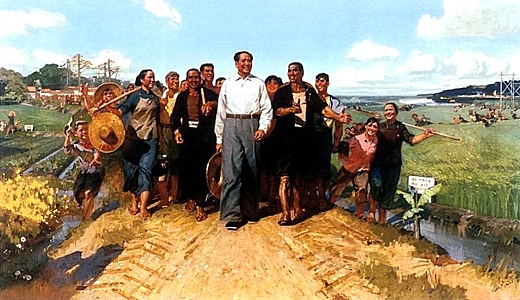 Image above: Painting of Chairman Moa Zedong visits Guandong countryside, by Chen Yanning, 1972. From (http://summerinshanghai.wordpress.com/2010/07/07/death-of-a-chinese-master).
Image above: Painting of Chairman Moa Zedong visits Guandong countryside, by Chen Yanning, 1972. From (http://summerinshanghai.wordpress.com/2010/07/07/death-of-a-chinese-master).
China’s urban population surpassed that of rural areas for the first time in the country’s history after three decades of economic development encouraged farmers to seek better living standards in towns and cities.
The world’s most-populous nation had 690.79 million people living in urban areas at the end of 2011, compared with 656.56 million in the countryside, the National Bureau of Statistics said today in Beijing. That puts the number of people residing in China’s towns and cities at double the total U.S. population.
China’s urbanization has accelerated since Deng Xiaoping introduced capitalist reforms in the late 1970s, lifting more than 200 million people out of poverty and transforming the nation into the world’s second-largest economy and its biggest consumer of steel, copper and coal. That migration may have decades more to run, diluting an agrarian economy that was once the ruling Communist Party’s power base.
“Urbanization has been a fundamental driver behind China’s economic growth,” said Chang Jian, an economist at Barclays Capital in Hong Kong who formerly worked for the Hong Kong Monetary Authority and the World Bank. “Urbanization in China still has a long way to go, maybe for another 20 years.”
China’s rural population fell as a proportion of the nation’s total to 50.05 percent in 2010 from 81 percent in 1979, as reform fueled a more than 90-fold increase in the economy during that time. During the first three decades of Communist Party rule, that proportion declined by less than 9 percentage points from 89.36 percent in 1949.
21st Century
Nobel economics laureate Joseph E. Stiglitz has cited urbanization in China, along with technology developments in the U.S., as the two most important issues that will shape the world’s development during the 21st century.
With more urbanization and industrialization ahead of it, China still needs investment to upgrade its industries and infrastructure, Ma Jiantang, commissioner of the National Bureau of Statistics, said today in a briefing in Beijing.
Urbanization will also provide “fundamental support” for investment growth and housing demand, Barclays’s Chang said.
China’s urbanization has already benefited companies such as excavators makers Caterpillar Inc. (CAT) and Komatsu Ltd. (6301), and iron ore miners BHP Billiton Ltd. (BHP) and Rio Tinto Plc. (RIO) Changing consumer tastes and growing wealth have also fueled demand for products sold by Apple Inc. (AAPL), General Motors Co. (GM) and Yum! Brands Inc. (YUM)
Income Gap
Income for the nation’s city dwellers is more than triple that of its rural residents. Per capita urban disposable income increased 8.4 percent in real terms last year to 21,810 yuan, according to the statistics bureau. By the same measure, per capita rural cash income increased 11.4 percent to 6,977 yuan, according to the agency.
The statistics bureau doesn’t provide disposable income statistics for rural residents because much of their annual earnings aren’t in cash, such as food they grow themselves.
Income growth for rural residents outpaced that for people in towns and cities in 2011 for a second consecutive year. Rural income grew faster in 2010 for the first time since 1997.
China’s rural poor have been the source of revolution throughout the nation’s history. Mao Zedong’s Communist Party took power in 1949 after winning the support of hundreds of millions of peasants living in the nation’s countryside. After the Communists’ victory, Mao redistributed land from rich landlords to penniless peasants.
As the nation’s urban population surges, China now faces the challenge of providing jobs, welfare and other social services to its city dwellers, Zheng Zhenzhen, a professor at the Institute of Population and Labor Economics at the Chinese Academy of Social Science, said by telephone today.
“One of the government’s top priorities now is to look after the lowest rungs of the urban population,” Zheng said.
.
No comments :
Post a Comment